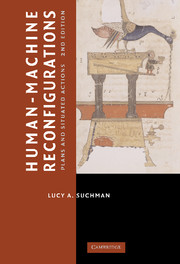Book contents
- Frontmatter
- Contents
- Acknowledgments
- Preface to the 2nd Edition
- Introduction
- 1 Readings and Responses
- 2 Preface to the 1st Edition
- 3 Introduction to the 1st Edition
- 4 Interactive Artifacts
- 5 Plans
- 6 Situated Actions
- 7 Communicative Resources
- 8 Case and Methods
- 9 Human–Machine Communication
- 10 Conclusion to the 1st Edition
- 11 Plans, Scripts, and Other Ordering Devices
- 12 Agencies at the Interface
- 13 Figuring the Human in AI and Robotics
- 14 Demystifications and Reenchantments of the Humanlike Machine
- 15 Reconfigurations
- References
- Index
12 - Agencies at the Interface
Published online by Cambridge University Press: 05 June 2012
- Frontmatter
- Contents
- Acknowledgments
- Preface to the 2nd Edition
- Introduction
- 1 Readings and Responses
- 2 Preface to the 1st Edition
- 3 Introduction to the 1st Edition
- 4 Interactive Artifacts
- 5 Plans
- 6 Situated Actions
- 7 Communicative Resources
- 8 Case and Methods
- 9 Human–Machine Communication
- 10 Conclusion to the 1st Edition
- 11 Plans, Scripts, and Other Ordering Devices
- 12 Agencies at the Interface
- 13 Figuring the Human in AI and Robotics
- 14 Demystifications and Reenchantments of the Humanlike Machine
- 15 Reconfigurations
- References
- Index
Summary
This chapter explores the technical practices and cultural imaginaries of the so-called smart machine, not in the form of hardware-based robots or dedicated “expert” systems but as a proliferating world of software algorithms and computationally infused objects and environments. If claims for the imminence of the humanoid machine that compelled initiatives in artificial intelligence and robotics during the 1980s subsequently lost their vigor, in the 1990s transformations in computational infrastructures breathed new life into the project of designing humanlike, conversational artifacts. Web-based and wireless technologies in particular inspired renewed attention to the interface as a site for novel forms of connection, both with and through computational devices. Futures projected through the imaginaries of AI and robotics have recently been elaborated within a discourse of software agents, knowbots, and their kin. At the same time, the transformation of the Internet into a preeminent site for commerce in the service economy lends additional currency to the promise of personified computational agents, available to provide multiple forms of personal assistance to their human employers.
Software agents and “smart” devices are the current expressions of a long-standing dream of artifacts that know us, accompany us, and ensure that we are always “at home.” Agent technologies offer the services of a proxy who travels while we stay in place, whereas distributed or “ubiquitous” computing, particularly in the form of “intelligent environments,” promises to provide us with greater mobility without a loss of familiar ground.
- Type
- Chapter
- Information
- Human-Machine ReconfigurationsPlans and Situated Actions, pp. 206 - 225Publisher: Cambridge University PressPrint publication year: 2006



